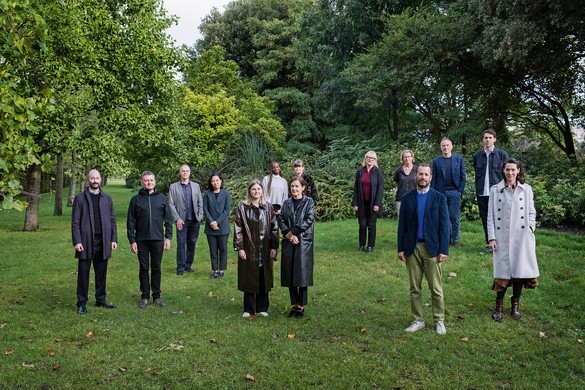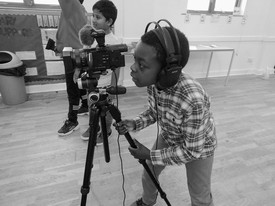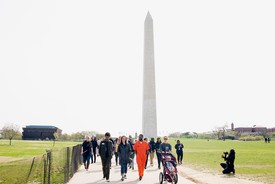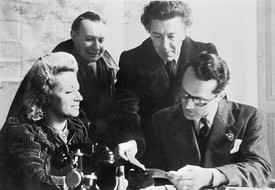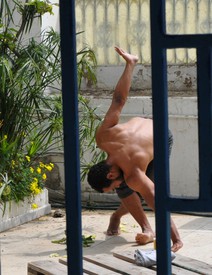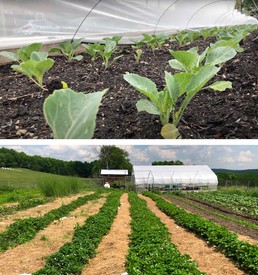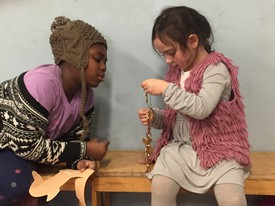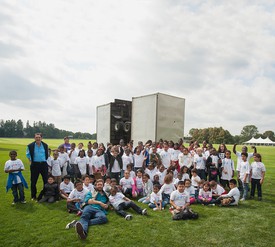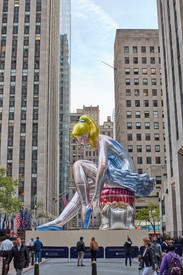
Heath Lowndes is managing director and cofounder of Gallery Climate Coalition (GCC), which he has led since its launch in October 2020. GCC is an international charity and membership organization set up to provide sector-specific resources and guidelines for environmental sustainability.

Adele Minardi joined Gagosian in 2013. Based in London as an artists’ liaison and exhibitions coordinator, she is a member of the gallery’s sustainability task force.

Victoria Siddall is board director at Frieze. She has worked with Frieze since 2004 and previously held the position of global director, overseeing the running of all four Frieze Art Fairs in London, New York, and Los Angeles. Siddall is a founding member of the Gallery Climate Coalition, a trustee of the Ampersand Foundation, and chair of the board of trustees of Studio Voltaire.
Adele MinardiIt’s been almost a year since you approached Gagosian, introducing us to the Gallery Climate Coalition [GCC]. How did the project begin? What were the initial ideas behind it?
Victoria SiddallWe started this conversation in London before the pandemic and we had our first formal meeting in January 2020. A group of us came together with this feeling that somebody in the art industry needed to take a lead in raising awareness around our impact on the environment in order to share resources to reduce carbon emissions. We knew that galleries and artists cared deeply about the climate but felt somewhat powerless to do anything about it. That was where the idea of a coalition came from. In the art world you have a lot of individuals and small businesses; we thought if we could bring everybody together, we could effect some real change across the industry.
[London gallerist] Thomas Dane initially had the idea to plan a summit, for summer 2020. We’d bring in leaders from other industries to share their wisdom and we’d see what came out of it. Then the pandemic struck, so our plans to bring everyone together in person had to change, but that gave us a bit more time to build GCC. We brought a group together weekly throughout 2020. [Website designer] Artlogic built an incredible carbon calculator for us; Scott & Co positioned our mission to the press. It was an amazing collaborative effort and GCC formed into what it is now because of the attention that people like this were able to give it. It started, really, with us agreeing on a goal in line with the Paris Agreement, which is a 50 percent reduction in carbon emissions by 2030.
The next steps were to give galleries the tools and the means to actually achieve this goal, which is where the carbon calculator came from. That’s on the GCC website and it’s tailored specifically to galleries. It’s very easy to use and it’s free. We’re encouraging all our members to do an annual carbon audit through the calculator.
And Adele, your bringing Gagosian on board was an incredibly important moment for us. GCC has grown so fast, given that we only made it public in October, and already we’ve got five hundred members and chapters forming in different parts of the world. It’s been inspiring to see how motivated people are to make this change.
AMYou mentioned that you grew from a group of individuals and galleries in London. Do you think there was something about the London scene in particular that gave rise to this coalition?
Heath LowndesIn terms of environmentalism, I wouldn’t say that the London art community was any more advanced than other cities; we just came together at the right moment and shared information, rather than working in isolation. As we spoke to our counterparts in Berlin, it became apparent that the situation there was similar. Individually, they had this drive to make a difference but hadn’t joined the dots yet within their own community.
It was Thomas Dane who brought together the original team. He knew that [Frieze cofounder] Matthew Slotover and Victoria had already been thinking about this topic for some time at Frieze. Thomas was also aware that [London gallerist] Kate MacGarry had been part of a panel discussion on climate issues at Art Basel, and that journalists Louisa Buck and Daisy Garnett also had interest in this area. Finally, [London gallerist] Sadie Coles, Greg Hilty [of Lisson Gallery], Peter Chater [of Artlogic], and Richard Scott [of Scott & Co] joined and we had our founding committee. Thomas was able to bring together this team of people who were passionate but not necessarily experienced—we’re all amateur environmentalists. The missing piece of the puzzle was Danny Chivers, our environmental advisor, who guided us through the process of research and resource development.
VSWith each city we engage, we see more people feeling the same way around the world. The galleries involved from the beginning were crucial; they showed there was this willingness to collaborate.
we found there were already a few people working at this intersection of climate activism and culture in the visual arts. So rather than being competitive and territorial, we instantly went to the space of collaboration.
Heath Lowndes
AMEveryone has a common goal and you’ve built a forum to bring people together in achieving it. Your digital-events series Conversations on Climate offers roundtable discussions, workshops, and more. Can you tell us more about your relationship with this community and the five hundred members you’ve reached?
HLWe’re a membership organization and we want members to be as active as possible. We ask members to return annual carbon reports, which entails collecting their information and entering it into the carbon calculator to record their emissions. Implementing the GCC guidelines is another way for members to be proactive: the climate crisis often feels insurmountable on a personal level, but these structures let individuals have a positive impact on it in a way that relates to their profession. We have research groups consisting of volunteer members across the world who contribute to research, which is then verified with our advisor and added to the website resource sections. That’s a very tangible contribution our members can make.
AMAlong with a number of other organizations in the field, the coalition recently launched this new model, PACT. Will you share more about that?
HLPACT stands for “Partners for Arts Climate Targets.” When we started, we found there were already a few people working at this intersection of climate activism and culture in the visual arts. So rather than being competitive and territorial, we instantly went to the space of collaboration. The group includes Art to Zero and Galleries Commit in New York, Art/Switch and Ki Culture in Amsterdam, ART 2030 from Denmark, and Art + Climate Action in San Francisco. We wanted to launch as a unified group to show that we’re working collaboratively toward the same targets. Each organization has its own programs, its own newsletters, but everyone has been inviting each other to their events and to share their resources.
AMHow can a gallery, or a private individual, an artist, say, become a member? And what, as a member, would they sign up for?
VSWhen we started this, we wanted to tailor it for galleries, for the commercial art world. But of course anyone would be welcome as a member. We’ve had individuals, artists, nonprofits, and collectors want to be part of this program. GCC is a charity, so we run on donations, which primarily come from our members and a few other generous individuals. But there’s no obligation to give money; we didn’t want barriers to people signing up. What we ask them to do is commit to the goal and give us a contact who will take responsibility for filling in the carbon calculator every year and for keeping their organization or studio, whatever it is, thinking about the goal. Those are the essentials, but people can be much more involved than that if they want to; we have committees devoted to different topics and in different parts of the world—London, Berlin, and now Los Angeles. We’ve got other international committees in formation, in Belgium, in Italy, in Brazil.
AMOne of the most important instruments you’ve provided is the carbon calculator tailored for the art world. Can you describe how it works?
HLYes, but it’s worth mentioning that there’s another art-sector calculator created by the London nonprofit Julie’s Bicycle, which predates ours and is much more complex. Their tool provides a very thorough audit of an organization. We can’t call ours an audit because we’ve favored user friendliness over gaining 1 or 2 percent more accuracy. It gives an incredibly accurate total for your carbon estimate without any hurdles. It was built in collaboration with our climate advisor, Danny Chivers, and Peter Chater. The tool was based on the results of carbon audits of our founding galleries that Danny conducted. The data showed that the most significant carbon emissions in the gallery sector quite clearly came from three sources: individuals’ air travel, the shipping of artworks by air freight, and building energy. We focus our resources and tools on those categories. The idea is that members can quite straightforwardly enter information relating to flights they’ve taken, shipments they’ve made, and their energy consumption for the year, and, completely for free, get an accurate estimate of their carbon emission.
VSKnowledge and information are vital in the fight against climate change. If you can’t measure, you can’t reduce. You need to know where your emissions are coming from to be in a position to solve the problem.
The other thing the tool is useful for is comparison. It’s useful for understanding the difference between an air shipment and a sea shipment, or traveling by train and traveling by plane, for example. Some of the differences are quite eye-opening.
INFORMATION IS POWER AND ALLOWS FOR BETTER DECISION-MAKING, NOT JUST FOR GALLERIES BUT FOR ARTISTS, COLLECTORS, EVERYBODY.
Victoria Siddall
AMYou mentioned that shipping, traveling, and the gallery building’s energy consumption are the three main areas of carbon emission. Of course we work in an industry in which we’re all used to traveling and to shipping art, so how can we overcome this challenge?
VSThe biggest category of emissions from the gallery audits that we’ve done so far is shipping. Coming from organizing art fairs, I’ve spoken with galleries over the years about shipping by sea and land rather than by air, which radically reduces carbon emissions. Galleries are often keen to do this but have faced challenges for a variety of reasons. What we realized we can do at GCC, as well as providing tools, is to lobby shippers and insurers, and have this conversation on behalf of galleries, large and small, from all over the globe. To their credit, we’ve found these industries to be very open to this conversation and we have made some positive progress already.
Information is power and allows for better decision-making, not just for galleries but for artists, collectors, everybody. That’s how we’re going to achieve this; that’s why the coalition aspect of it is really important.
HLPeople working in isolation wouldn’t have the same influence over suppliers, shippers, and other bodies in the industry. We have the power to align people with science-based, sector-specific information and apply pressure in effective ways to instigate systemic change.
AMWhat would you suggest a private individual in the art world, an artist or collector, could ask and push for?
VSIt’s the same for everybody: being aware and mindful in decision-making. Galleries are often in the middle and how they ship a work isn’t always their decision. If the work is ready in time to ship by sea and land, great; if it’s not, the gallery may not have a choice. It’s important to raise awareness so that everyone in the chain can make consistent decisions together. We’re not being critical of any group or individual here, we don’t want to hinder anybody’s business, we just want to allow for informed and mindful decisions. We’re not an activist organization; we’re here to support an industry to do better.
AMSo a gallery joins GCC, uses the carbon calculator—what happens next?
HLCalculating annual emissions is the very important first step. You won’t know your target without measuring. We advise starting with 2019 as a pre-covid baseline. After that, members will understand the impacts of all their activities. The next step would be to apply the guidelines incrementally toward the final target. Another major step is to communicate those operational changes to colleagues, clients, artists, and everyone in the supply chain. It’s essential that they understand the reason why delivery times have changed, or why a two-day transatlantic trip isn’t possible anymore, or why they can’t use certain packaging materials. By explaining the reasoning, you’re more likely to get people to be accommodating about potential compromise, and the transition will be smoother. It’s ultimately about incremental steps and meaningful changes that are long-lasting and effective rather than temporary.
AMWhat we don’t often think about is that reducing carbon emissions often means reducing costs. That’s something that should really help organizations make this change.
VSThat’s a really important point: these changes can improve people’s business. Shipping by land and sea is often cheaper than shipping by air, as well as having lower emissions. So, a double win.
What we don’t often think about is that reducing carbon emissions often means reducing costs. That’s something that should really help organizations make this change.
Adele Minardi
AMDo you think that governments will eventually make changes in environmental regulations and will ask the art world to step forward in calculating and showing its goals and emissions?
VSVery possibly, but I also think it’s important that we’re not relying on any one government here. The art industry is global, it operates across many countries, and those countries have very different political systems. I don’t think we should wait for all those governments to put policies in place. We can take the lead as an industry and decide to do better than we’re required to by law.
HLI agree with that, totally. Having said that, governments will have to respond; they will have to implement legislation to enforce this. The British government increased its reduction target to 78 percent by 2035, which seems hugely ambitious and begs further explanation as to how they intend to reach that. But as Victoria said, it’s not about waiting for other people to give you these instructions. When governments do step up and introduce robust carbon laws, GCC members will be well prepared to respond and already well on their way to sustainability.
AMThis October will mark the first year since your launch. What are your proudest accomplishments over the past year?
VSThe speed with which the galleries and the art world have embraced this mission and goals. The support has been global and has gone beyond the gallery world. We have all the leading galleries signed up, across the whole spectrum. The auction house Christie’s has signed up and made the same commitment, as has Frieze. Artists and nonprofits have signed up: MoMA PS1, Nottingham Contemporary, and others. So it’s a really interesting mix.
HLI would say I’m proud of the membership structure. We’ve had these incredible volunteers who have mobilized in a way to make it possible. In addition to our very small core team, we have a few freelancers and pro bono contributors without whom we couldn’t have got this far. But it’s our network of generous volunteers who are really the engine of the machine. The art world can be competitive; they’ve put all that aside to work together for the greater good. That’s incredibly inspiring.
Another achievement we’re proud of is being invited to present at the United Nations as part of a high-level event on the cultural response to the climate crisis. It was an honor to be recognized in that space.
AMWhat do you expect to achieve in the next year and beyond?
VSOver the next couple of years, I see a group coming together in every significant gallery city in the world. Each will run independently and have its own local advice and principles for sustainability. Ideally this movement should become something that if you’re not part of, if you haven’t signed up to this goal to reduce emissions, people raise an eyebrow.
We’re also working to raise funds for ClientEarth, an international law firm that acts on behalf of the planet and holds governments to account. While the art world certainly produces emissions, its share in the grand scheme of the planet is relatively small. ClientEarth recently closed down a coal-fired power station in Poland whose annual emissions were three times that of Europe’s biggest airline. It’s making huge changes that are vital to the future of the planet.
In the art world, we’re very good at generating attention and raising funds. To raise the profile of ClientEarth, and of the urgent work they do, within the art community, GCC is planning a series of auction sales that will run over the course of a year, starting in October, to coincide with COP26 [the United Nations Climate Change Conference of the Parties] this fall. We didn’t want to hold a single auction in a single location because we didn’t want to ship work from all over the world to one place. We also wanted a sustained campaign that would generate attention over a period of time. The first sale will be a painting that Cecily Brown has very generously donated, which will be sold in a Christie’s evening sale in London. We then have a series of works given by artists, including a painting by Rashid Johnson and a sculpture by Antony Gormley, that will be sold at Christie’s over the next twelve months. The proceeds will enable ClientEarth to continue in their incredibly important work.
Gallery Climate Coalition’s schedule of auction sales in partnership with Christie’s to support ClientEarth includes: London, October 15, 2021; New York, November 9, 2021; Hong Kong, December 1, 2021; and future auctions to be announced for the February and June sales in 2022. These are part of the newly launched initiative Artists for ClientEarth.
